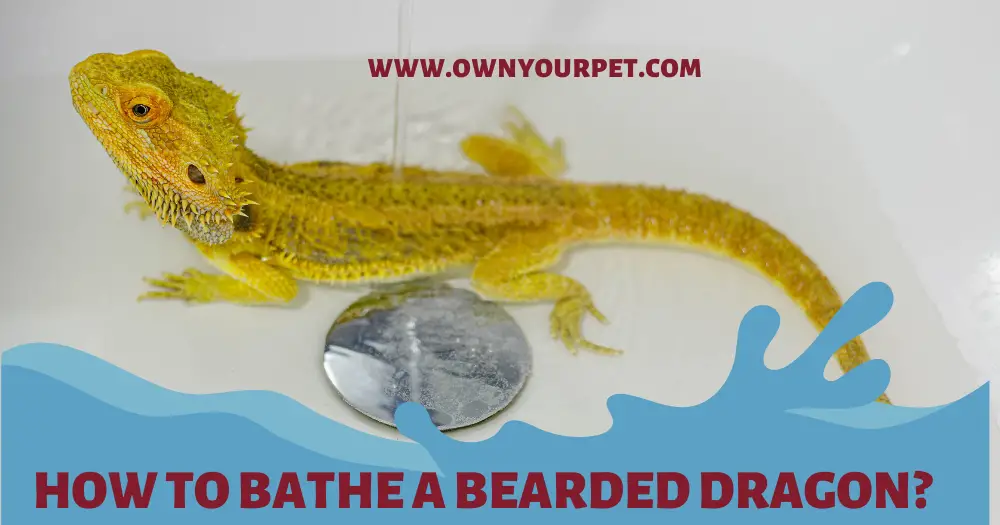Bearded dragons are popular reptile pets known for their interesting personalities and ease of care. One important aspect of keeping a bearded dragon healthy and comfortable is ensuring proper hygiene through regular bathing. You may have been wondering, “How to Bathe a Bearded Dragon?”
Bathing not only keeps your dragon clean but also promotes hydration, better skin health, and improved digestion.
To bathe a bearded dragon effectively, following a few simple steps to ensure their safety and comfort is essential. The process involves using an appropriate bathing container, maintaining the correct water temperature, and allowing the dragon enough time to relax and soak in the water.
Familiarizing yourself with these steps will help make the bathing experience enjoyable for both you and your bearded dragon.
In this article, we’ll discuss the step-by-step process of bathing a bearded dragon to ensure you provide them with the best care possible. By following these guidelines, you’ll not only keep your beloved pet clean and healthy, but also strengthen the bond between you and your scaly companion.
Why Bathe Bearded Dragons?
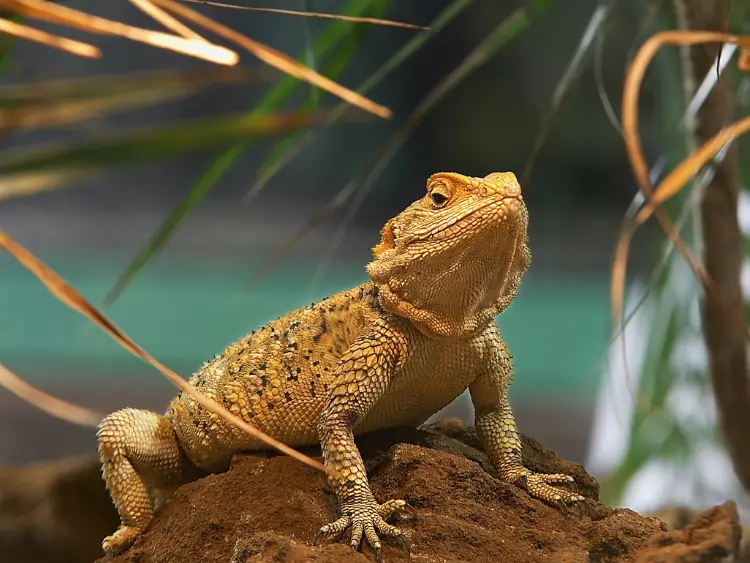
Bearded dragons can benefit from regular baths for a variety of reasons. One important aspect is improving their hygiene. Bathing helps remove dirt, debris, and any other particles clinging to their skin. This keeps their environment clean and prevents the buildup of bacteria and germs that can lead to infections or other health problems.
In addition to hygiene, bathing also plays a vital role in the overall health of bearded dragons. Soaking in water can help with hydration, ensuring that your reptile is receiving enough water to maintain proper bodily functions. Adequate hydration is essential for their overall well-being and helps with digestion and nutrient absorption.
Moreover, baths can aid in the shedding process that bearded dragons undergo regularly. Soaking in warm water can help to soften the old skin, making it easier for the new skin to emerge. Daily baths for about fifteen minutes can significantly assist during shedding periods, particularly if the shed is difficult or stubborn.
Furthermore, bathing bearded dragons contributes to better skin health. Proper skin care is crucial as it plays a significant role in their general health, preventing conditions like scale rot or other skin infections. Keeping the skin clean and hydrated protects them from these potential health issues.
Lastly, baths can also positively impact a bearded dragon’s digestive health. When they soak in the water, it can help trigger a bowel movement, keeping their digestive system functioning optimally. Regular baths can therefore assist in maintaining a healthy digestion process.
Overall, bathing your bearded dragon offers numerous benefits. From maintaining good hygiene and promoting skin health to helping with shedding, hydration, and digestion, baths are essential for your bearded dragon’s overall health and well-being.
How To Give A Bearded Dragon A Bath The Right Way !!! Tips And Tricks
Preparing for the Bath
Choose a Container
When preparing to bathe your bearded dragon, selecting the appropriate container is essential. A tub or a small basin, such as a bathtub or a bathroom sink, will work well for this purpose. You can also use a plastic box specifically designed for reptile bathing.
Water Temperature
The water temperature should be closely monitored for your bearded dragon’s comfort and safety. Make sure the water is lukewarm, ideally between 85-92°F (29-33°C). Using a thermometer is helpful to ensure the water is at the correct temperature. Keep checking the water temperature during the bath and adjust accordingly to maintain warmth.
Water Depth
When filling the container, keep the water depth shallow—about the height of your bearded dragon’s limbs. This allows them to feel secure and still have their head above water. Your bearded dragon should be able to comfortably sit in the water with their head and upper body above water.
Bath Additives and Substances
It is crucial to avoid using soap, chemicals, or any additives as they can harm your bearded dragon’s skin and overall health. Stick to clean, warm water for the bath. After the bath, you can provide a basking light to help your bearded dragon dry off and maintain their body temperature.
Bathing the Bearded Dragon
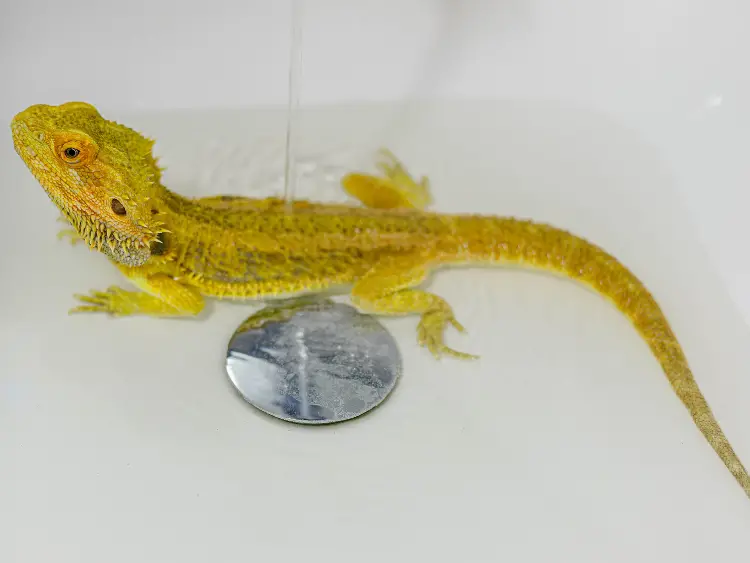
Step by Step Process
- Fill the tub or large container with warm water: The water should be between 85°F and 100°F (29.4°C and 37.7°C). For baby and juvenile bearded dragons, fill the bath with about half an inch to one inch of water. For adults, you can fill the bath with one to three inches of water, depending on their size.
- Gently place your bearded dragon in the water: Ensure they can comfortably touch the bottom and that their head is above the water’s surface.
- Let the dragon soak and play: This helps them get comfortable and can aid in hydration, digestion, and overall cleanliness.
- Use a soft toothbrush or cloth to gently clean your dragon’s skin and remove loose substrate: Be cautious around their eyes, nostrils, and mouth – do not force water into these sensitive areas.
- Rinse the bearded dragon gently: Using a container or cup to scoop water and pour it over the dragon’s body, carefully avoiding their head.
- Remove the dragon from the water and place them onto a towel: Use the towel to gently pat them dry. Be thorough, but avoid rubbing the skin too hard as this could cause irritation.
- Return your bearded dragon to their basking spot: Ensure they are fully dry before placing them back into the enclosure.
Stress-Reducing Tips
- Supervision: Never leave your bearded dragon unsupervised in the water. Bearded dragons can easily drown if they are unsupervised or if the water is too deep.
- Use the right object: Place an object in the tub/container that your bearded dragon can grip or climb onto if they feel uncomfortable or need a break from the water.
- Clean the enclosure: Regularly clean your bearded dragon’s enclosure with a solution of water and white vinegar to help maintain good hygiene and reduce the frequency of baths.
- Frequency: Bathe your bearded dragon once per week or as needed, depending on their individual needs, activity level, and enclosure cleanliness.
Remember to always prioritize your bearded dragon’s safety and comfort during bathing. Observing stress-reducing practices helps make the experience enjoyable for both you and your pet.
Cleaning Specific Areas
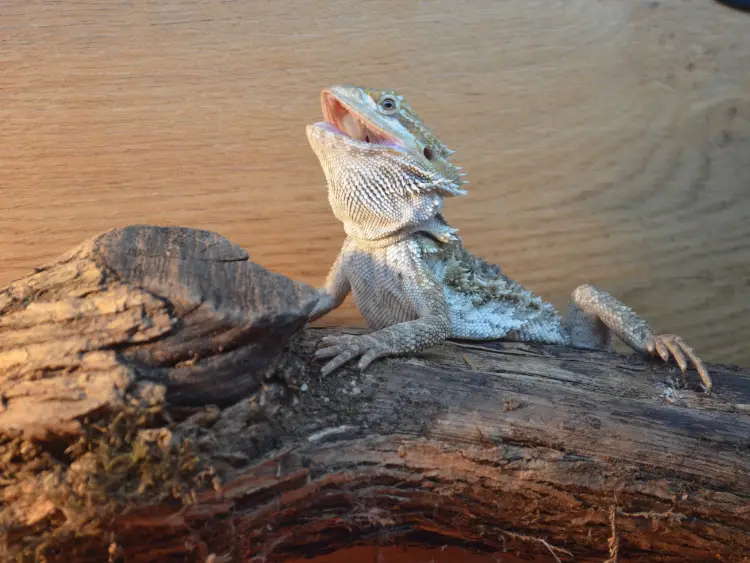
When bathing your bearded dragon, you should also pay attention to specific areas such as the scales, cloaca, and feet. This section will discuss various techniques and methods for cleaning these areas effectively.
Toothbrush Technique
Using a soft-bristled toothbrush can be an excellent way to help clean tight spots and remove debris from your bearded dragon’s scales.
- Begin by dipping the toothbrush in clean water.
- Gently brush the scales in a circular motion, being careful not to apply too much pressure.
- Ensure the toothbrush reaches between the scales for a thorough clean.
Remember to avoid getting too close to the eyes or nose to prevent irritation.
Brushing Scales
The scales are essential to your bearded dragon’s skin, and proper care must be taken when cleaning them. Excessive dirt or debris accumulating in the scales can lead to discomfort and potential health issues.
To clean the scales, simply follow the toothbrush technique mentioned above. Pay special attention to the regions around the tail, limbs, and body.
Cleaning the Cloaca
The cloaca is a sensitive area where your bearded dragon eliminates feces. It is important to keep this area clean to avoid infections or health issues.
- Fill a small container with warm water and place your bearded dragon inside, ensuring the water level covers the cloaca.
- Let your dragon soak in the water for a few minutes to help loosen any dried feces.
- Gently clean the area using your soft-bristled toothbrush or a clean cloth, paying close attention to the surrounding skin.
- Once you’ve finished cleaning the cloaca, pat the area dry with clean paper towels.
Regular baths will help maintain your bearded dragon’s overall hygiene, including the cloaca area. Make sure to always observe your bearded dragon for any signs of distress or discomfort during the cleaning process.
Drying and After-Bath Care
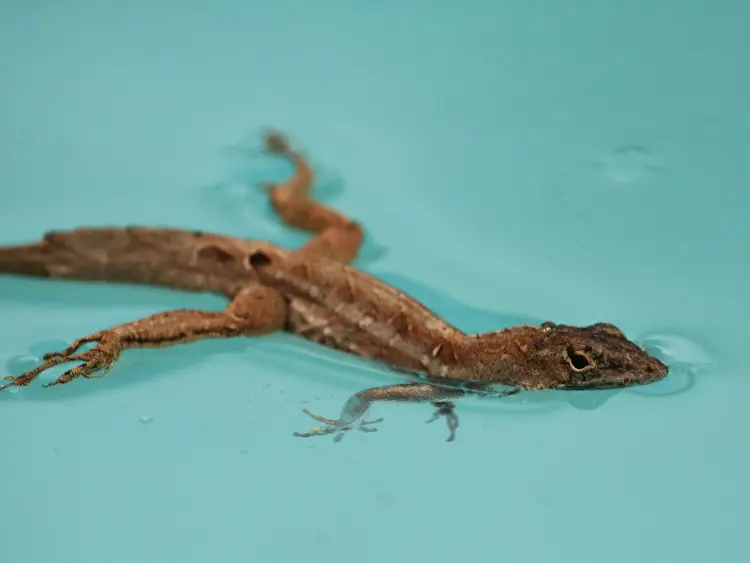
After giving your bearded dragon a bath, it’s essential to dry them off to ensure their comfort and health properly. Gently remove your bearded dragon from the water and place them on a clean, soft towel.
You can use another towel to carefully pat them dry, paying attention to their limbs and the area under their chin. Be gentle to avoid harming your pet’s delicate skin. Reptile Guide recommends using a water temperature of about 90-100 degrees Fahrenheit for the bath.
It’s important to understand that reptiles, like bearded dragons, are sensitive to humidity levels in their environment. After drying them with a towel, allow your bearded dragon some time under their basking light to ensure complete drying.
The basking light will help evaporate any remaining moisture on their skin and facilitate the regulation of their body temperature.
Once your bearded dragon is completely dry, you may wish to perform additional after-bath care activities. For instance, you can use a soft brush to remove any shed skin or dead scales still adhering to their bodies. This will assist in maintaining their skin health.
In conclusion, drying and after-bath care for bearded dragons play a crucial role in their overall well-being. By following these simple procedures, you’ll be helping your pet maintain proper hygiene and avoid any potential health concerns related to moisture and humidity.
Remember always to handle your bearded dragon gently and ensure their environment is kept at the appropriate temperature for their comfort and safety.
Bathing Frequency and Special Considerations
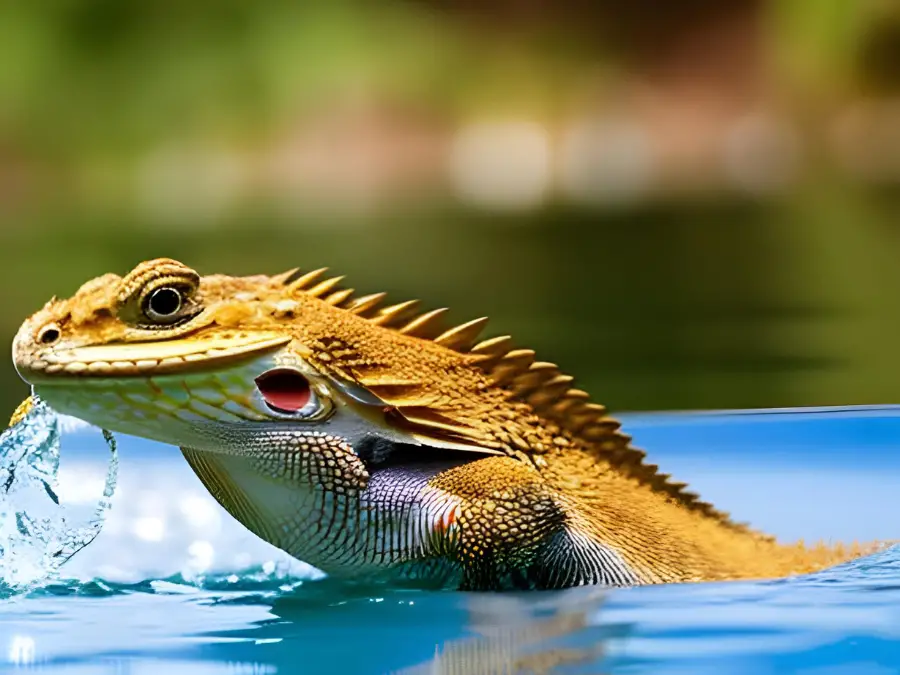
By Age and Size
Bearded dragons of different ages and sizes have varying bathing requirements. Here’s a general guideline for bearded dragon bath frequency:
- Babies (0-6 months): Twice a week
- Juveniles (6-12 months): Once a week
- Adults (1 year and older): Every 10-14 days
These recommendations may vary depending on your bearded dragon’s specific needs, as well as your personal preferences and time constraints.
Signs of Dehydration
When your bearded dragon is dehydrated, it may need more frequent baths to help rehydrate. Signs of dehydration in bearded dragons include:
- Skin that retains its shape when pinched
- Sunken eyes
- Lack of energy
- Decreased appetite
If you notice any of these signs, consider increasing the bathing frequency and providing additional water sources, such as a water bowl or misting the enclosure.
Shedding and Impaction
During the shedding process, bearded dragons benefit from more frequent baths to help soften the shedding skin and promote a smooth shedding process. When your bearded dragon is shedding, you can increase the bathing frequency to every other day.
Impaction, or constipation, is another common issue in bearded dragons. Occasional baths can help with impaction by providing relaxation to their digestive system.
If your bearded dragon shows signs of impaction, such as a bloated belly, lethargy, or a lack of bowel movements, increase the bathing frequency and consult a veterinarian if the issue persists.
When bathing your bearded dragon, consider the following factors:
- Keep the water level shallow, covering only their legs and belly
- Ensure water is warm but not too hot, with a temperature between 85-92°F (29-33°C)
- Gently massage their belly to help with the shedding process or impaction
Please remember that while these guidelines provide a good starting point, always observe your bearded dragon’s behavior and consult a reptile specialist or veterinarian for individual advice.
Health and Safety Concerns
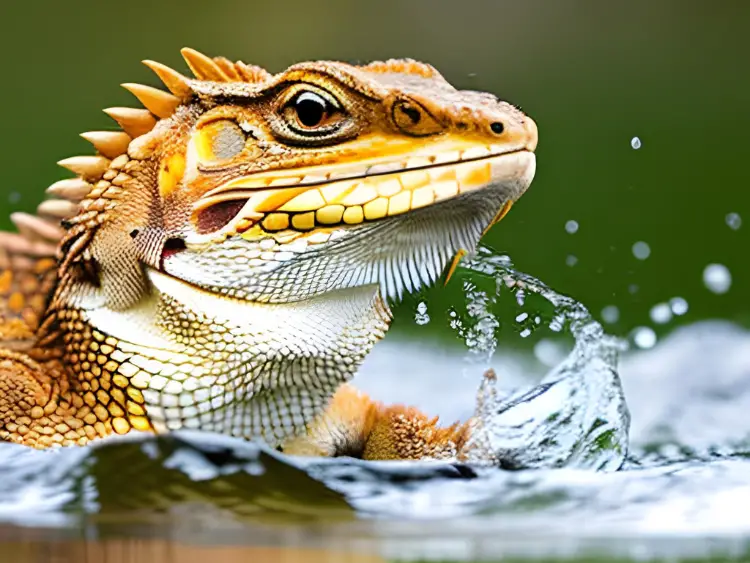
Drowning Prevention
One significant concern while bathing a bearded dragon is the risk of drowning. Maintaining safety and welfare while giving your beardie a bath is essential. Make sure to keep the water level in the bathtub or basin shallow (no more than the dragon’s shoulders) to minimize the risk of drowning.
Furthermore, avoid leaving your bearded dragon unattended during bath time and always make sure their head stays above water.
Preventing Infection
In addition to drowning prevention, it’s essential to keep your bearded dragon’s health in mind during bathing to minimize the risk of infection.
- Bacteria and Fungus: Dirty water can expose your beardie to harmful bacteria and fungi, potentially leading to various health issues. To minimize this risk, using clean, warm water for your bearded dragon’s bath is crucial. A good practice is to thoroughly clean the tub or container before use and consider using reptile-safe water conditioners to eliminate contaminants.
- Salmonella Prevention: Bearded dragons can carry salmonella bacteria, so it’s critical to maintain good hygiene while bathing your dragon. Wash your hands thoroughly with soap and water before and after handling your bearded dragon and any items used during bathing.
- Water Temperature: Ensuring the proper water temperature is essential for your bearded dragon’s health and comfort. Use warm water (around 85°F to 95°F) for their bath, close to the dragon’s basking temperature. Continuously monitor water temperature and adjust it as needed to keep your bearded dragon comfortable and safe during their bath.
The Impact on Bonding and Behavior
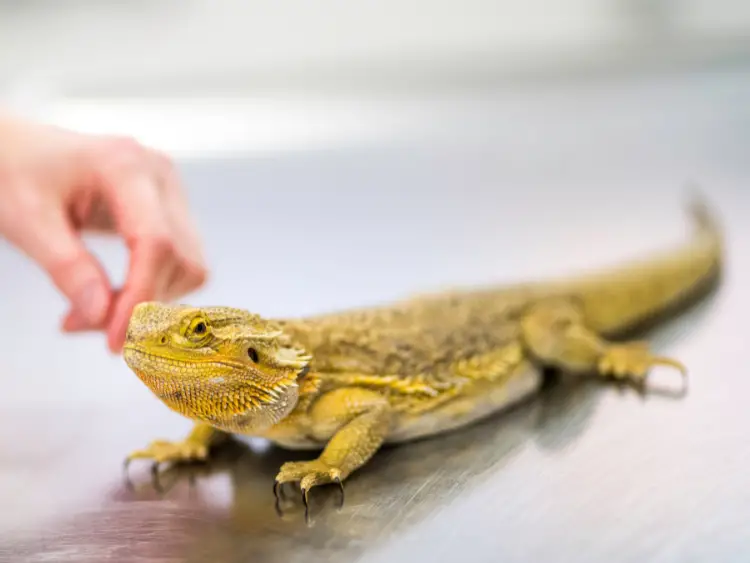
Bathing your bearded dragon has numerous benefits, one of which is promoting bonding between you and your pet, as well as positively impacting its behavior. Regular baths allow you to spend quality time with your bearded dragon, making them feel secure and comfortable around you.
Hygiene is essential for bearded dragons, and bathing helps maintain their cleanliness. During baths, you can gently brush your bearded dragon to remove any dirt, old skin, and debris that may have accumulated in their terrarium. A clean bearded dragon is a happy bearded dragon, and this will lead to better overall behavior and health.
The frequency of bathing your bearded dragon is also crucial. A weekly bath is typically sufficient, but you can increase the frequency during shedding periods or if they defecate in the terrarium. Consistency in the bathing schedule will help your beardie anticipate and enjoy the routine, making them more cooperative during the process.
Besides baths, misting your bearded dragon regularly can also help maintain their overall cleanliness and hydration. Misting with a spray bottle filled with water helps keep your bearded dragon’s skin moist and healthy. However, it is crucial not to over-mist, as excessive humidity can cause respiratory issues.
In summary, bathing is an essential aspect of caring for your bearded dragon, as it fosters bonding, ensures cleanliness, and encourages positive behavior. Regular baths, coupled with proper terrarium maintenance and misting, will contribute to the well-being of your beloved pet.
Additional Materials and Accessories
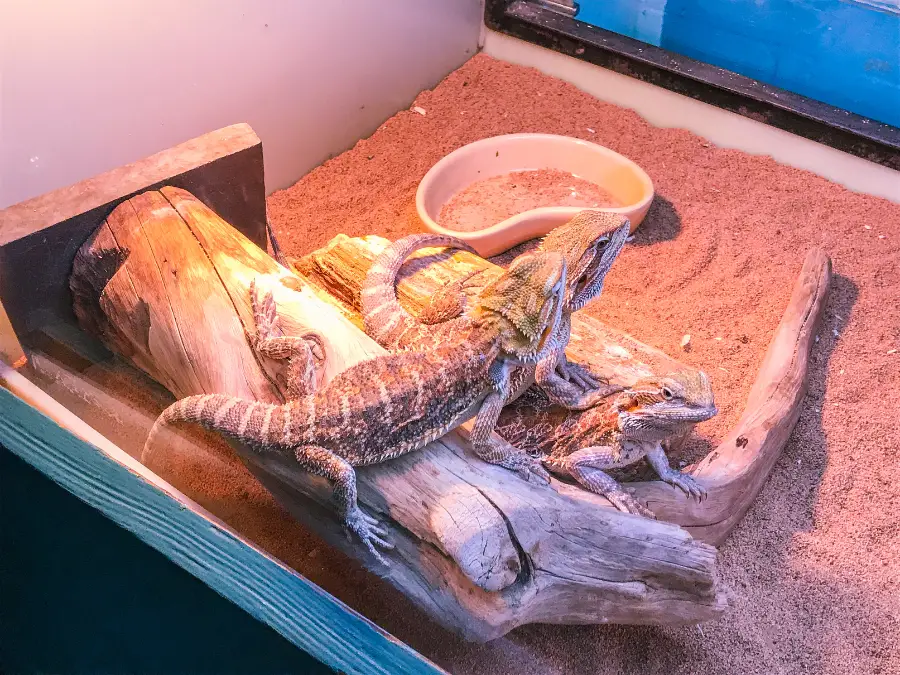
When bathing your bearded dragon, having the right materials and accessories is important to ensure your pet’s safe and enjoyable experience.
Basin
Choose a basin with an appropriate size to accommodate your bearded dragon comfortably. A bathtub, kitchen sink, or plastic storage bins can work well, but avoid basins with slippery surfaces or sharp edges. The basin should be clean and exclusively used for your pet’s bathing to prevent contamination or possible injuries.
Water
Use warm water to fill the basin, with a temperature between 85-92°F to maintain a comfortable body temperature during the bath. Ensure the water is neither too hot nor too cold, as it can cause stress or even harm your dragon. The water level should be shallow, not surpassing your bearded dragon’s shoulder.
Loose Substrate and Old Skin
One of the benefits of bathing your bearded dragon is helping with better skin health by removing the loose substrate and old skin. Gently rubbing their skin with a soft toothbrush can aid in the process. Be mindful not to press too hard and avoid the eyes, mouth, and nostrils.
Toys
Bearded dragons sometimes enjoy playing with floating toys while being bathed. Small, water-friendly toys can help entertain your bearded dragon during their bath. Ensure the toys are clean and safe for reptiles.
Material
Gently clean your bearded dragon’s body using a soft cloth or sponge. Some bearded dragon owners also recommend adding a small amount of aloe vera to the water to aid in their skin health. Be sure to mix the aloe vera into the water and avoid using any harsh soaps or chemicals, as these can irritate their skin.
Gathering the appropriate materials and accessories ensures your bearded dragon has a safe, comfortable, and enjoyable bathing experience.
FAQs
Q: Why is bathing important for bearded dragons?
A: Bathing serves multiple purposes for bearded dragons. It helps them stay hydrated, promotes shedding of dead skin, and can provide relief from dry skin.
Q: Is it necessary to use a heat lamp during the bath?
A: Using a heat lamp during the bath is unnecessary. Ensure that the bathing area is warm enough to keep your bearded dragon comfortable without the need for additional heat.
Q: Can adult bearded dragons benefit from baths too?
A: Yes, adult bearded dragons can also benefit from regular baths. It helps maintain their skin and hydration levels, and they may also enjoy the relaxing experience.
Q: How can I tell if my bearded dragon needs a bath?
A: Signs that your bearded dragon may need a bath include visibly dry or flaky skin, difficulty shedding, or if they haven’t had a bowel movement in a while. However, regular bathing is still recommended even without these signs.
